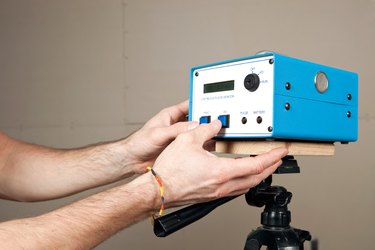
Found everywhere in the air you breathe and in soil, radon is a radioactive gas that forms when the uranium in rocks and soil breaks down. Although it's perfectly natural, exposure to large amounts of radon gas may lead to lung cancer. Unfortunately, radon often finds its way from soil into homes. Once there, radon sometimes becomes trapped and builds to dangerous levels. Since it has no color, odor or taste, radon testing is the only way to know if the radon levels in your home are safe or a cause for concern. A variety of conditions can affect a radon test, however, and lead to inaccurate readings.
Test Placement and Movement
Video of the Day
Because radon gas comes from uranium found in soil and rock, it enters homes on their lowest level. As a result, the best location for a radon test unit is on the lowest livable level of your home. The word livable is key here. You can place your radon test in your basement even if it's unfinished, but you need not place a test kit in a crawl space or other area that will never get used as living space.
Video of the Day
Raise your test kit at least 20 inches off the floor and keep it a foot away from outside walls. Maintain a clear area of 4 inches around the test kit to allow for adequate circulation, and place the kit out of direct sunlight, drafts and areas of high humidity.
Once the kit is placed, it's imperative that you don't move it. A change in the placement of a radon detector may skew the test results. All people living in the home should agree not to disturb the equipment. If you have concerns, place a motion detector or sensor on the kit to alert you of any disturbances.
Current Weather Conditions
Changes in barometric pressure and humidity can both alter radon test results, so try to avoid testing during periods of rain, thunderstorms and high wind. Radon readings tend to go down when outdoor wind speeds increase and during periods of high humidity. The changing seasons also affect radon testing. Indoor radon testing shows higher levels of radon in homes during fall and winter than in spring and summer
Drafts and Ventilation
An accurate radon test requires closed house conditions. All windows and doors, with the exception of normal entrances and exits, should remain closed for the duration of the test. Opening and closing doors and windows will change the ventilation and temperature in the home, temporarily changing the radon level as well. For a short-term test of fewer than four days, closed conditions should begin at least 12 hours before starting the test.
Remember that some household appliances will alter the airflow in your home as well. Window and attic fans, fireplaces and wood-burning stoves all create drafts and pull air through your home. Don't use these appliances during a radon test unless, of course, the wood-burning stove is your primary heat source.
Duration of Test
Because so many factors can influence a radon test, the length of the test matters. Short-term radon tests last between two and seven days. While they give you a snapshot of your radon levels over the course of a week, they may not paint the entire picture.
For a more accurate reading of your home's radon level as they fluctuate over time, consider a long-term test. These tests show radon levels in the home over the course of three months to one year, alerting you of potentially dangerous fluctuations a short-term test may miss. If you plan to do only a short test, do it during a still, dry period over the winter when radon levels are likely to be at their highest.
Radon Test Results
Radon test kits measure radon levels in picoCuries per liter (pCi/L). All you need to understand about this complex measurement is that a reading between one and three is average. A reading of four or higher, however, indicates that you have a radon problem you need to address.
Don't panic and slap a for sale sign on your house though. Radon remediation companies are plentiful and can help you lower the radon levels in your home by sealing your basement and foundation. When necessary, a radon remediation team will also install a vent pipe that draws the radon into the pipe and then funnels it out of your home.
Radon mitigation costs vary based on the type of system and size of your home. The average cost for radon mitigation is $978, but some systems can cost up to $3,000 if you have a complex situation.